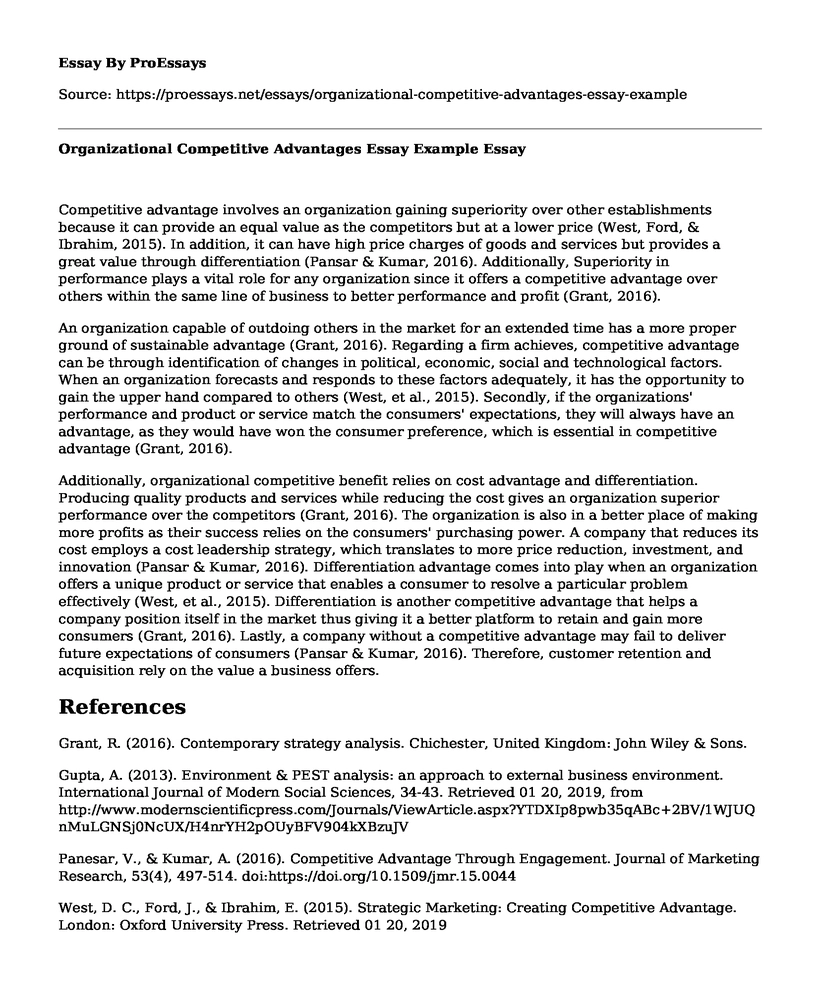Competitive advantage involves an organization gaining superiority over other establishments because it can provide an equal value as the competitors but at a lower price (West, Ford, & Ibrahim, 2015). In addition, it can have high price charges of goods and services but provides a great value through differentiation (Pansar & Kumar, 2016). Additionally, Superiority in performance plays a vital role for any organization since it offers a competitive advantage over others within the same line of business to better performance and profit (Grant, 2016).
An organization capable of outdoing others in the market for an extended time has a more proper ground of sustainable advantage (Grant, 2016). Regarding a firm achieves, competitive advantage can be through identification of changes in political, economic, social and technological factors. When an organization forecasts and responds to these factors adequately, it has the opportunity to gain the upper hand compared to others (West, et al., 2015). Secondly, if the organizations' performance and product or service match the consumers' expectations, they will always have an advantage, as they would have won the consumer preference, which is essential in competitive advantage (Grant, 2016).
Additionally, organizational competitive benefit relies on cost advantage and differentiation. Producing quality products and services while reducing the cost gives an organization superior performance over the competitors (Grant, 2016). The organization is also in a better place of making more profits as their success relies on the consumers' purchasing power. A company that reduces its cost employs a cost leadership strategy, which translates to more price reduction, investment, and innovation (Pansar & Kumar, 2016). Differentiation advantage comes into play when an organization offers a unique product or service that enables a consumer to resolve a particular problem effectively (West, et al., 2015). Differentiation is another competitive advantage that helps a company position itself in the market thus giving it a better platform to retain and gain more consumers (Grant, 2016). Lastly, a company without a competitive advantage may fail to deliver future expectations of consumers (Pansar & Kumar, 2016). Therefore, customer retention and acquisition rely on the value a business offers.
References
Grant, R. (2016). Contemporary strategy analysis. Chichester, United Kingdom: John Wiley & Sons.
Gupta, A. (2013). Environment & PEST analysis: an approach to external business environment. International Journal of Modern Social Sciences, 34-43. Retrieved 01 20, 2019, from http://www.modernscientificpress.com/Journals/ViewArticle.aspx?YTDXIp8pwb35qABc+2BV/1WJUQnMuLGNSj0NcUX/H4nrYH2pOUyBFV904kXBzuJV
Panesar, V., & Kumar, A. (2016). Competitive Advantage Through Engagement. Journal of Marketing Research, 53(4), 497-514. doi:https://doi.org/10.1509/jmr.15.0044
West, D. C., Ford, J., & Ibrahim, E. (2015). Strategic Marketing: Creating Competitive Advantage. London: Oxford University Press. Retrieved 01 20, 2019
Cite this page
Organizational Competitive Advantages Essay Example. (2022, Nov 07). Retrieved from https://proessays.net/essays/organizational-competitive-advantages-essay-example
If you are the original author of this essay and no longer wish to have it published on the ProEssays website, please click below to request its removal:
- Consumer Ethnocentrism Among Youthful Indians
- Children's Mercy Healthcare Facility Analysis
- Supply Chain Aspects That Leads to the Success of Dell Essay
- Research Paper Example on Consumer Behavior
- Research Paper on Oxfam Organization
- 2 Responsibilities for Each Position to Avoid HAC Penalty: Board Pres, CFO, CMO - Essay Sample
- Essay Sample on Organizational Transformation: Strategies for Success







